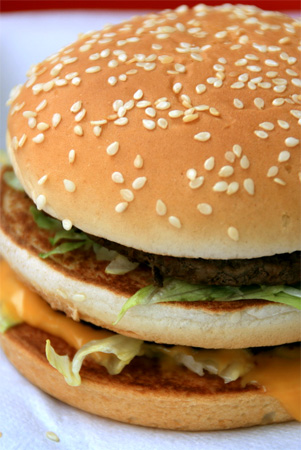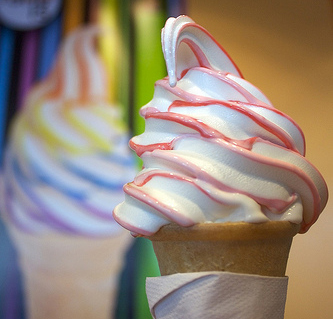The Big Mac index was created in September 01986 by the Economist magazine to help determine Purchasing Power Parity between two currencies by using the price of a Big Mac as the intermediary. The Big Mac Index is a quick and simple way of calculating if a given currency is under or over-valued. The system isn’t perfect, but it is a quick metric none the less.
 Over the last 25 years, the idea of calculating purchasing power based on local wages and the price of a mass-produced, common object has taken off as a metric to determine standard of living as well as exchange rates.
Over the last 25 years, the idea of calculating purchasing power based on local wages and the price of a mass-produced, common object has taken off as a metric to determine standard of living as well as exchange rates.
Common objects such as; the price of IKEA furniture, Big Macs, Greggs sausage rolls, and now even iPods, have been used to help determine his Purchasing Power Parity variable. All these objects have in common that they are relatively available in a diverse cross-segment of places around the world, but some of these objects work better than others. The iPod for example is wholly built in one places and distributed world-wide, so any disparity in pricing is purely artificial rather than due to locally sources ingredience or parts.
Given that common food and consumer products are usually marketed and priced in some relation to the target markets’ wages. You can tell if a currency is over- or under-valued as well as how high or low the standard of living is in an area when you compare how many hours you need to work to purchase one. By the looking at the market price of everyday objects in your area compared to the world-wide average it can forecast economic problems.
Iceland’s Collapse
In late 02007, the Icelandic Economy collapsed. There are plenty of reasons and excuses why, but seemingly few people saw it coming—or if they did, stayed quiet to profit from it. In 02007, the Economist had the Icelandic Krónur as the most over-valued currency in the world based on the Big Mac Index and they were probably right!
Within a year of the crash, McDonalds was doomed in Iceland. Firstly, it was never very popular, only one or two stores in Reykjavik proper and maybe only a few others dotted around the country. As is in most cases, Subway out numbers McDonalds by a larger margin. When the value of the Icelandic currency, the krónur, fell through the floor and inflation pushed prices up, it became near impossible for the local franchise owner to continue to buy official McDonalds ingredient from main-land Europe to satisfy franchise requirements. Therefore, they announced they were going to close-up all the McDonalds in Iceland.
Naturally, there were lines around the block to get one last taste of that Big Mac before it disappeared forever from this tiny island. Luckily, the owners knew a good thing when they saw it and kept the McDonalds open, but completely rebranded them as Metro. It is exactly the same restaurant, the menu is the same to the point where they just put stickers over the “Mc” on most products. What is different is that the ingredients are not from a McDonalds distributor, but from other sources—one would hope local.
 McDonalds past the torch in early November 02009 to the new Metro. A year later I went back to see how things have been getting on. Somewhere in the previous twelve months they purchased a very fancy ice cream machine. It was called Randís and added some gel flavouring to the ice cream swirl. It is designed to gently fade between 4 to 5 flavours, but the results were disastrous. Nothing like the promotional photos!
McDonalds past the torch in early November 02009 to the new Metro. A year later I went back to see how things have been getting on. Somewhere in the previous twelve months they purchased a very fancy ice cream machine. It was called Randís and added some gel flavouring to the ice cream swirl. It is designed to gently fade between 4 to 5 flavours, but the results were disastrous. Nothing like the promotional photos!
Instead of a rainbow of flavoured colours, you ended-up with brown sludge. Even the staff at the drive thru windows were apologetic and warned customers that it” isn’t what they expect!” So now, in late 02010, they only allow you to choose two possible colours so the overall experience isn’t ruined.
I ordered one when I ate there. I opted for a single color, strawberry. As you can see from the photo, the swirls were about right, it was certainly edible and the experience was good, but not as nice as the promotional shot—they never are. As long as they keep the flavor mixing to a minimum they have found that sweet spot.
One interesting rumor that circulates is that the taste of the french fries is slowly getting worse and worse. This is in part due to the oil they are fried in. When they could no longer purchase McDonalds ingredients from their suppliers, they simply diluted the oil so some of the original flavour persisted. Over time, the dilution has gotten so thin there is very little left of the original oil. Not being a french fry connoisseur it is impossible for me to confirm or deny these aligations.
It is interesting to watch a new brand piggy-back an established one by the same owners. It doesn’t seem that the name change has affected sales, which makes you wonder if people are loyal to a brand specifically or whether they continue to shop/eat there because it fits into their life-style niche? Or perhaps the mimicry that Metro has setup against McDonalds has been so effective that the strong brand association has transferred along with everything on the menu?
It is unlikely that McDonalds will return to Iceland soon. Most burger chains don’t do well, Burger King closed-up after the crash and others never stood a chance. Partly because there are plenty of excellent local shops that will happily sell you a better burger with a less plasticy, shrink wrapped experience.
Since the economic meltdown, Iceland has been delisted from the global Big Mac Index. I guess it is a good thing that the McDonalds Theory of War wasn’t true. The theory was that no two countries with McDonalds have ever gone to war with each other, which has since been disproven. Had it been true, the McDonalds’ pulled out of Iceland could have meant a bumpy ride ahead.
Goodbye and so long to the Big Mac Index and Ronald McDonald Diplomacy.